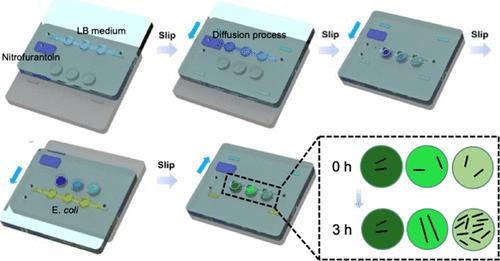Our official English website, www.x-mol.net, welcomes your feedback! (Note: you will need to create a separate account there.)
Formation and Parallel Manipulation of Gradient Droplets on a Self-Partitioning SlipChip for Phenotypic Antimicrobial Susceptibility Testing
ACS Sensors ( IF 8.9 ) Pub Date : 2022-07-11 , DOI: 10.1021/acssensors.2c00734 Xu Liu 1 , Xiang Li 1 , Nannan Wu 2 , Yang Luo 1 , Jiajie Zhang 1 , Ziqing Yu 1 , Feng Shen 1
ACS Sensors ( IF 8.9 ) Pub Date : 2022-07-11 , DOI: 10.1021/acssensors.2c00734 Xu Liu 1 , Xiang Li 1 , Nannan Wu 2 , Yang Luo 1 , Jiajie Zhang 1 , Ziqing Yu 1 , Feng Shen 1
Affiliation

|
Flexible, robust, and user-friendly screening systems with a large dynamic range are highly desired in scientific research, industrial development, and clinical diagnostics. Droplet-based microfluidic systems with gradient concentrations of chemicals have been demonstrated as promising tools to provide confined microenvironments for screening tests with small reaction volumes. However, the generation and manipulation of gradient droplets, such as droplet merging, generally require sophisticated fluidic manipulation systems, potentially limiting their application in decentralized settings. We present a gradient-droplet SlipChip (gd-SlipChip) microfluidic device that enables instrument-free gradient droplet formation and parallel manipulation. The device can establish a gradient profile by free interfacial diffusion in a continuous fluidic channel. With a simple slipping step, gradient droplets can be generated by a surface tension-driven self-partitioning process. Additional reagents can be introduced in parallel to these gradient droplets with further slipping operations to initiate screening tests of the droplets over a large concentration range. To profile the concentration in the gradient droplets, we establish a numerical simulation model and verify it with hydrogen chloride (HCl) diffusion, as tested with a dual-color pH indicator (methyl orange and aniline blue). As a proof of concept, we tested this system with a gradient concentration of nitrofurantoin for the phenotypic antimicrobial susceptibility testing (AST) of Escherichia coli. The results of our gd-SlipChip-based AST on both reference and clinical strains of E. coli can be indicated by the bacterial growth profile within 3 h and are consistent with the clinical culture-based AST.
中文翻译:

用于表型抗菌药物敏感性测试的自分区滑动芯片上梯度液滴的形成和平行操作
在科学研究、工业发展和临床诊断中,非常需要具有大动态范围的灵活、强大和用户友好的筛查系统。具有化学梯度浓度的基于液滴的微流体系统已被证明是一种很有前途的工具,可以为具有小反应体积的筛选测试提供受限的微环境。然而,梯度液滴的生成和操纵,例如液滴合并,通常需要复杂的流体操纵系统,这可能会限制它们在分散环境中的应用。我们提出了一种梯度液滴滑动芯片 (gd-SlipChip) 微流体装置,该装置可实现无仪器梯度液滴形成和平行操作。该装置可以通过连续流体通道中的自由界面扩散来建立梯度分布。通过一个简单的滑动步骤,梯度液滴可以通过表面张力驱动的自分配过程产生。可以将额外的试剂与这些梯度液滴平行引入,并进行进一步的滑动操作,以开始在大浓度范围内对液滴进行筛选测试。为了描绘梯度液滴中的浓度,我们建立了一个数值模拟模型,并通过氯化氢 (HCl) 扩散对其进行了验证,并使用双色 pH 指示剂(甲基橙和苯胺蓝)进行了测试。作为概念验证,我们使用梯度浓度的呋喃妥因对该系统进行了表型抗菌药敏试验 (AST) 的测试。可以将额外的试剂与这些梯度液滴平行引入,并进行进一步的滑动操作,以开始在大浓度范围内对液滴进行筛选测试。为了描绘梯度液滴中的浓度,我们建立了一个数值模拟模型,并通过氯化氢 (HCl) 扩散对其进行了验证,并使用双色 pH 指示剂(甲基橙和苯胺蓝)进行了测试。作为概念验证,我们使用梯度浓度的呋喃妥因对该系统进行了表型抗菌药敏试验 (AST) 的测试。可以将额外的试剂与这些梯度液滴平行引入,并进行进一步的滑动操作,以开始在大浓度范围内对液滴进行筛选测试。为了描绘梯度液滴中的浓度,我们建立了一个数值模拟模型,并通过氯化氢 (HCl) 扩散对其进行了验证,并使用双色 pH 指示剂(甲基橙和苯胺蓝)进行了测试。作为概念验证,我们使用梯度浓度的呋喃妥因对该系统进行了表型抗菌药敏试验 (AST) 的测试。我们建立了一个数值模拟模型,并通过氯化氢 (HCl) 扩散对其进行了验证,并使用双色 pH 指示剂(甲基橙和苯胺蓝)进行了测试。作为概念验证,我们使用梯度浓度的呋喃妥因对该系统进行了表型抗菌药敏试验 (AST) 的测试。我们建立了一个数值模拟模型,并通过氯化氢 (HCl) 扩散对其进行了验证,并使用双色 pH 指示剂(甲基橙和苯胺蓝)进行了测试。作为概念验证,我们使用梯度浓度的呋喃妥因对该系统进行了表型抗菌药敏试验 (AST) 的测试。大肠杆菌。我们基于 gd-SlipChip 的 AST 对参考和临床大肠杆菌菌株的结果可以通过 3 小时内的细菌生长曲线来指示,并且与基于临床培养的 AST 一致。
更新日期:2022-07-11
中文翻译:

用于表型抗菌药物敏感性测试的自分区滑动芯片上梯度液滴的形成和平行操作
在科学研究、工业发展和临床诊断中,非常需要具有大动态范围的灵活、强大和用户友好的筛查系统。具有化学梯度浓度的基于液滴的微流体系统已被证明是一种很有前途的工具,可以为具有小反应体积的筛选测试提供受限的微环境。然而,梯度液滴的生成和操纵,例如液滴合并,通常需要复杂的流体操纵系统,这可能会限制它们在分散环境中的应用。我们提出了一种梯度液滴滑动芯片 (gd-SlipChip) 微流体装置,该装置可实现无仪器梯度液滴形成和平行操作。该装置可以通过连续流体通道中的自由界面扩散来建立梯度分布。通过一个简单的滑动步骤,梯度液滴可以通过表面张力驱动的自分配过程产生。可以将额外的试剂与这些梯度液滴平行引入,并进行进一步的滑动操作,以开始在大浓度范围内对液滴进行筛选测试。为了描绘梯度液滴中的浓度,我们建立了一个数值模拟模型,并通过氯化氢 (HCl) 扩散对其进行了验证,并使用双色 pH 指示剂(甲基橙和苯胺蓝)进行了测试。作为概念验证,我们使用梯度浓度的呋喃妥因对该系统进行了表型抗菌药敏试验 (AST) 的测试。可以将额外的试剂与这些梯度液滴平行引入,并进行进一步的滑动操作,以开始在大浓度范围内对液滴进行筛选测试。为了描绘梯度液滴中的浓度,我们建立了一个数值模拟模型,并通过氯化氢 (HCl) 扩散对其进行了验证,并使用双色 pH 指示剂(甲基橙和苯胺蓝)进行了测试。作为概念验证,我们使用梯度浓度的呋喃妥因对该系统进行了表型抗菌药敏试验 (AST) 的测试。可以将额外的试剂与这些梯度液滴平行引入,并进行进一步的滑动操作,以开始在大浓度范围内对液滴进行筛选测试。为了描绘梯度液滴中的浓度,我们建立了一个数值模拟模型,并通过氯化氢 (HCl) 扩散对其进行了验证,并使用双色 pH 指示剂(甲基橙和苯胺蓝)进行了测试。作为概念验证,我们使用梯度浓度的呋喃妥因对该系统进行了表型抗菌药敏试验 (AST) 的测试。我们建立了一个数值模拟模型,并通过氯化氢 (HCl) 扩散对其进行了验证,并使用双色 pH 指示剂(甲基橙和苯胺蓝)进行了测试。作为概念验证,我们使用梯度浓度的呋喃妥因对该系统进行了表型抗菌药敏试验 (AST) 的测试。我们建立了一个数值模拟模型,并通过氯化氢 (HCl) 扩散对其进行了验证,并使用双色 pH 指示剂(甲基橙和苯胺蓝)进行了测试。作为概念验证,我们使用梯度浓度的呋喃妥因对该系统进行了表型抗菌药敏试验 (AST) 的测试。大肠杆菌。我们基于 gd-SlipChip 的 AST 对参考和临床大肠杆菌菌株的结果可以通过 3 小时内的细菌生长曲线来指示,并且与基于临床培养的 AST 一致。



























 京公网安备 11010802027423号
京公网安备 11010802027423号